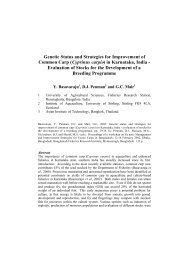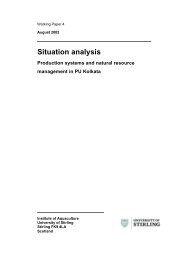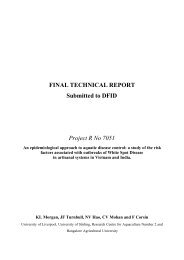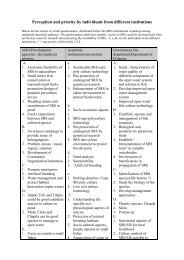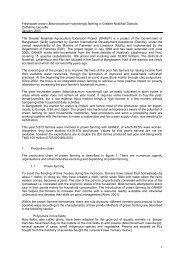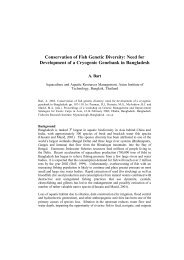Epizootic Ulcerative Syndrome (EUS) Technical Handbook
Epizootic Ulcerative Syndrome (EUS) Technical Handbook
Epizootic Ulcerative Syndrome (EUS) Technical Handbook
Create successful ePaper yourself
Turn your PDF publications into a flip-book with our unique Google optimized e-Paper software.
EpidemiologyEpidemiology is the study of the distribution and determinants (i.e. causes) ofdisease in populations. Epidemiologists typically take a wide view of causalfactors, defining them as ‘any event, condition or characteristic that plays anessential role in producing an occurrence of disease’. By contrast, manypathologists and microbiologists may consider, for example, a particularinfectious agent to be the cause of a disease, and may relegate all othercontributions to “contributing” or “predisposing” factors.For most diseases, including <strong>EUS</strong>, there is strong evidence that outbreaksoccur only when a number of causal factors combine. Many of the causalfactors that have been identified or suggested, on the basis of reasonableevidence, for <strong>EUS</strong> may be represented in a causal web (Figure 3). Note thatthere are several levels within the web and that a number of factors may actat the same level (but not necessarily at the same time or intensity). Note alsothat, for <strong>EUS</strong> to occur, combinations of causal factors must ultimately lead toexposure of dermis, attachment to it by A. invadans, and subsequent invasionby the fungus of dermis and muscle. The resulting mycotic granulomatousdermatitis and myositis are, by definition, <strong>EUS</strong>.The multifactorial nature of <strong>EUS</strong> causation can also be represented using theconcepts of necessary cause, component cause and sufficient cause. Eachcombination of various causal factors (‘component causes’) which togethercause a disease is known collectively as a ‘sufficient cause’ for that disease(Figure 4). It is important to recognise that, under different circumstances,different combinations of ‘component causes’ may constitute sufficientcause for a disease. Moreover, all sufficient causes for a particular diseasehave in common at least one component cause, known as a ‘necessarycause’. This necessary cause must always be present for that disease tooccur.Figure 4. Schematic representation of the sufficient cause of a multifactorialdisease. Note that factor A is the only component cause common to allsufficient causes, and is therefore the only necessary cause.Sufficient cause 1 Sufficient cause 2 Sufficient cause 3EDHGJIABCABFACF33




